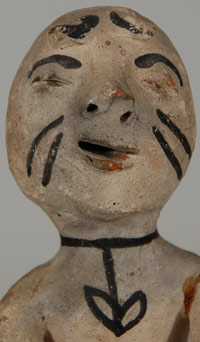Tesuque Pueblo Rain God Figurine with Hair and Warrior Marks [SOLD]
+ Add to my watchlist Forward to Friend
- Category: Figurines
- Origin: Tesuque Pueblo, TET-SUGEH
- Medium: clay, pigment
- Size: 6” Tall
- Item # C3343B SOLD
 The origin of Tesuque Rain Gods is still somewhat in question. They may be an indigenous development out of a more general Tewa tradition. Before the emergence of the figurine as we know it today, there existed figurines closely related to Kokopelli, the humpbacked, phallic flute player. These early figurines displayed sexual characteristics of male and female genders. A strong similarity exists between these ancestral Rain God figurines and the late 19th-century ones. The sexual characteristics disappeared rapidly once the figurines became commercial products.
The origin of Tesuque Rain Gods is still somewhat in question. They may be an indigenous development out of a more general Tewa tradition. Before the emergence of the figurine as we know it today, there existed figurines closely related to Kokopelli, the humpbacked, phallic flute player. These early figurines displayed sexual characteristics of male and female genders. A strong similarity exists between these ancestral Rain God figurines and the late 19th-century ones. The sexual characteristics disappeared rapidly once the figurines became commercial products.
Their entry into the commercial realm was due to a Santa Fe merchant named Jake Gold and possibly a Chicago, IL Candy Company called Gunther Candy. It has been stated for decades that Gunther offered to buy "Indian relics" to put in their boxes of candy, however this has not been confirmed.
Gold offered Tesuque potters ten cents for each figurine. The potters removed the sexual characteristics from the dolls (probably at the request of Gold) and placed a pot in the lap or on the head. Thus we have the Rain God, as we know it today.
This fine example of a Tesuque Rain God, which probably dates to circa 1900, has sculpted hair and warrior marks on his cheeks. He wears a painted necklace and holds a jar in his lap.
Condition: the left arm has been broken and glued; otherwise the doll is in very good condition for its age.
Provenance: from the collection of a former Santa Fe resident.
Recommended Reading: When Rain Gods Reigned: From Curios to Art at Tesuque Pueblo by Duane Anderson
- Category: Figurines
- Origin: Tesuque Pueblo, TET-SUGEH
- Medium: clay, pigment
- Size: 6” Tall
- Item # C3343B SOLD



